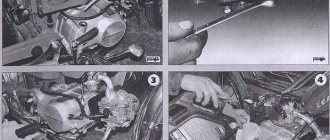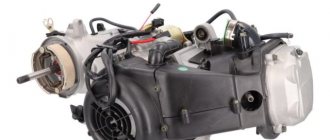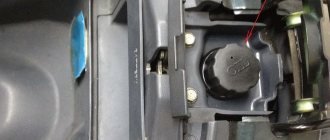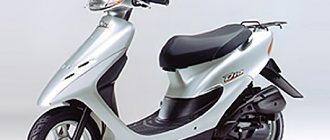Four-stroke scooter engines are subject to increased loads during operation in urban conditions. To prevent premature wear of metal surfaces, it is necessary to use lubricants. One such product is Motul SCOOTER EXPERT 4T oil. Thanks to this product, fuel consumption is significantly reduced. Reduces wear and provides consistent corrosion protection.
Product Description
The oil is made from synthetic-based materials with the addition of a complex of high-quality additives (Technosynthese technology). The lubricating fluid ensures stable operation of the clutch in an oil bath. The product has stable properties that are maintained during sudden temperature changes, as well as overheating in city driving conditions. It has a low level of volatility, which reduces the cost of constantly replenishing the oil level in the engine. Thanks to additives, it prevents the appearance of dirt and carbon deposits on internal surfaces.
The line includes two types of oil: Motul SCOOTER EXPERT 4T 10W40 MA and Motul SCOOTER EXPERT 4T 10W40 MB. Both products are semi-synthetic, but are superior in quality to many synthetic oils from other brands.
Suitable for mixing with mineral and synthetic oils, no negative reactions have been observed.
What oil to use in a 4t scooter
Scooter oils can be of a synthetic type (such lubricants are obtained by long-term chemical synthesis), as well as mineral (which are made by oil distillation). This type of lubricant is much less preferable for pouring into a scooter, since this lubricant quickly loses its properties during operation. Also, this type of lubricant contaminates the 4-stroke scooter engine and makes its operation even more unstable.
It is important to consider: in principle, you should not mix several types of oils for a scooter engine, except in rare cases if you are in the middle of the road and do not have the opportunity to purchase a similar product here and now.
Remember that for almost any type of 4-stroke scooter engine, it is best to buy a synthetic lubricant.
Specifications
Motul SCOOTER EXPERT 4T 10W-40 MA
| Parameter | Test method | Value/Units |
| Viscosity grade | SAE J 300 | 10W-40 |
| Density at 20°C (68°F): | ASTM D1298 | 0.874 g/cm3 |
| Viscosity at 40°C (104°F): | ASTM D445 | 95.4 mm²/s |
| Viscosity at 100°C(212°F): | ASTM D445 | 14.9 mm²/s |
| Viscosity index: | ASTM D2270 | 164 |
| Pour point: | ASTM D97 | -33°C / -27°F |
| Flash point: | ASTM D92 | 228°C / 442°F |
| Base number | ASTM D2896 | 7.9 mg KOH/g |
Motul SCOOTER EXPERT 4T 10W-40 MB
| Parameter | Test method | Value/Units |
| Viscosity grade | SAE J 300 | 10W-40 |
| Density at 20°C (68°F): | ASTM D1298 | 0.864 g/cm3 |
| Viscosity at 40°C (104°F): | ASTM D445 | 102.1 mm²/s |
| Viscosity at 100°C(212°F): | ASTM D445 | 14.6 mm²/s |
| Viscosity index: | ASTM D2270 | 150 |
| Pour point: | ASTM D97 | -35°C / -31°F |
| Flash point: | ASTM D92 | 232°C / 449.6°F |
| Base number | ASTM D2896 | 7.1 mg KOH/g |
Choosing the right oil
However, I decided to put together several companies that I think can be used in your scooter.
- Let's start with Shell helix ultra lubricant. The product is of excellent quality and has a positive effect on the scooter motor, and has also been able to establish itself in the market and among motorcycle enthusiasts. The oil is also suitable for scooter engines. Shell Ultra series is capable of improving the riding characteristics of the scooter. The series motor lubricant has proven itself when working in the most dangerous conditions.
- Lukoil of almost all series. What are the advantages of such motor oils? The company's lubricants contain many additives that can distinguish this oil from products of equal price.
- Top-level Rosneft oils are essentially the ideal choice for those who want to keep their scooter in the best working condition. The product can effectively compete with other brands - the lubricant has excellent characteristics and has a positive effect on the scooter engine. With this oil, the scooter will not be afraid of strong temperature changes. The oil does not emit harmful vapors during operation and does not evaporate into the air.
An excellent option would be a special oil for SCOOTER scooters. It is one of the most advanced and has also proven itself to be excellent.
Important: changing engine oil must be done according to the established plan and without time delays.
If you don’t look at the cost of the product, we have before us perhaps the best oil for a scooter motor if the mini-moped is purchased for many years.
Advantages and disadvantages
The main advantages include:
- the product forms a stable protective film on metal surfaces;
- has enhanced cleaning and dispersing properties, which prevents the formation of dirt and deposits on internal surfaces;
- at maximum loads, premature wear is prevented;
- provides stable protection against corrosion and rusting;
- does not undergo oxidation, foam does not form as a result of the ingress of water vapor;
- thanks to the use of oil, fuel consumption is reduced;
- ensures stable starting at low temperatures, and also prevents overheating during city driving.
There were no consumer deficiencies noted.
To pour or not to pour car engine oil into a motorcycle? Personal experience and laboratory analysis
What happens if you pour car engine oil into a motorcycle? Car oils are usually much more affordable than motorcycle oils. However, there are many opinions on this matter on online forums. Oil manufacturers advocate using only specialized oils, colorfully describing their benefits in advertising brochures, but without going into detail.
I filled my motorcycle with automotive engine oil, rode it 3,300 km and sent fresh and used oil to the laboratory. So I was able to understand how much the key parameters of the oil have deteriorated over a long run, how often it needs to be changed, and whether it’s worth getting involved with car oils at all or whether you’ll still have to trust the manufacturers.
There are many oils on the shelves with all sorts of marketing claims, but the most expensive is not always the best.
Content
- Synthetics, semi-synthetics and mineral water
- How often do you change the oil?
- Practice
- Laboratory test
- conclusions
The lubrication system in a motorcycle is different from a car, so the oil in them works under different conditions. On most motorcycles (but not all), the engine oil also services the transmission and clutch. These components require different properties from the oil, sometimes mutually exclusive. So, if friction-reducing additives are desirable for a cylinder-piston group (cylinder-piston group), then they will not be beneficial for a wet clutch. However, most automobile oils in the lower and middle price ranges do not have such additives and, according to this criterion, are suitable for motorcycles.
The red zone starts at 9.5 thousand rpm. By motorcycle standards, this is a medium-speed engine
Synthetics, semi-synthetics and mineral water
The division of oils into mineral, semi-synthetic and synthetic does not accurately reflect reality.
- In different countries, hydrocracked oils can be legally called either synthetic or semi-synthetic.
- According to the API (American Petroleum Institute) classification, base oils are divided not into 3, but into 5 different groups.
- The finished motor oil can consist of a mixture of two base oils of different categories and viscosity indices.
For example, a small proportion of PAO (API category 4, synthetics) and a very small proportion of esters (category 5, synthetics) are often added to hydrocracking motor oil (API category 3). Most likely, the packaging of such oil will say “Fully synthetic”, despite the fact that the hydrocracking base is made from crude oil. From different manufacturers (and in different price categories) it refers either to mineral water, or to semi-synthetics, or to full synthetics.
Now “synthetics” and “mineral water” have become more marketing terms than technical ones. It is much more useful for the buyer not to chase “synthetics”, but to choose an oil with a suitable viscosity index for your vehicle (and weather conditions), monitor the oil level and change it on time.
How often do you change the oil?
“Change your oil on time” usually means changing it twice as often as the specified service interval. For cars it is 15,000-20,000 km. For motorcycles, the 10,000 km interval specified in some manuals is also excessively long. Especially when it comes to operation in the city, where there are traffic jams, frequent acceleration and braking cycles, driving short distances on a not fully warmed-up engine, dust and reagents on the roads.
City driving = harsh operating conditions . With them, engine oil ages and loses its properties much faster. Therefore, many motorcyclists change their oil every 2,000-2,500 km.
But how justified is this? There is an opinion that in a car, over a long run, the viscosity of the oil begins to increase, and in a motorcycle, on the contrary, it begins to fall, as if the motorcycle transmission literally “grinds” the oil, lowering its viscosity. This opinion is also supported by reviews like “I filled up the oil, then after 7,000 km I drained the water.”
Practice
I bought a popular 10W-40 automotive motor oil and filled it in my Bajaj Pulsar NS200 motorcycle. in taking it for “arctic” frosts ( 5W -40, 0W -40): I don’t ride a motorcycle in sub-zero temperatures. And oil with a viscosity of 10W-40 will work reliably at both -10°C and -15°C.
The purchased oil complies with API SN, ACEA A3/B4 approvals, is suitable for both gasoline and diesel passenger engines, has a full package of additives (the most common additives, just in sufficient quantities) and good detergent properties, judging by the high alkaline number.
There are many oils with a viscosity of 10W-40 and API SN, ACEA A3/B4 approvals, and most of them are inexpensive. They are produced with a full package of additives, which is determined by tolerances and not by a specific manufacturer. In this case I used Castrol Magnatec 10W-40 A3/B4 oil. Based on some indirect indications, I believe that it does not use a polymer thickener (or does use it, but in a minimal amount), but perhaps it is prone to varnishing over long runs. This is another reason to use flushes when changing the oil.
“On paper,” this oil should retain its properties over a longer mileage than similar ones with a reduced additive package, retain detergent and dispersant properties longer, and not lose viscosity longer. But the laboratory will show how it will actually be.
The oil level is closer to the upper limit of normal. The total volume of oil to be filled is 1.2 liters
I filled the oil on November 16, 2021, mothballing the motorcycle for the winter for three and a half months in an unheated garage. The season opened on March 4, and by mid-August I had driven 3,300 km. I drove both around the city and on the highway, the trips were both short and 400 km per day. And even (not) easy enduro on dusty, broken rural roads.
↑Video review of the Bajaj Pulsar NS200 motorcycle↑
The motorcycle is carburetor, single-cylinder, before the replacement it was driven on the same oil, but only 1,000 km. Before it, the first 5,000 km were driven by Motul 7100. It is curious that a liter of hydrocracked 10W-40 automobile oil turned out to be almost three times cheaper than Motul motorcycle oil. I was very interested in the question: would there be a noticeable difference in the behavior of the motorcycle when changing the oil?
Bad roads often lead to good places
I will say that in general the habits of the motorcycle have not changed. Gear shifting was clear and predictable, and remains so. Neutral is easy to catch. The idle speed after warming up is stable, the maximum speed has not changed. I have never had any “clutch slipping”, which is often feared on forums, in 3,300 km of driving. The engine sound may have become more high-pitched (but this is very subjective), but there are two reasons for this: I adjusted the valves at the same time as the oil change, and the viscosity changed from 10W-50 (more viscous) to 10W-40.
After 3,300 km, a small amount of metal shavings appeared on the coarse oil filter magnet (pictured). So, if you evaluate the performance of the oil only by the amount of chips on the magnet, then it protects the engine well. Previously, with a different oil, there were more chips, but then the motorcycle was run-in and the comparison is not very correct.
Collecting samples of fresh and used oil in special flasks for sending to the laboratory
Laboratory test
Results from the laboratory showed that in 3,300 km the oil went from viscosity class 10W-40 to class xxW-20. Viscosity dropped almost twofold at low temperatures (from 96 cCt to 56 cCt at 40°C) and by 34% at operating temperature (from 13.8 cCt to 9.1 cCt at 100°C). This is a significant drop, so it’s clearly not worth driving 5,000 km on such oil. Despite the decrease in oil viscosity, no increased wear is observed; all indicators from the laboratory are within normal limits. It is worth remembering that this is a 200 cc single-cylinder high-speed engine (cruising at 7-8 thousand rpm in 6th gear), the service life of which is lower than that of its large-capacity counterparts. Therefore, slightly increased values of wear metals in mining should not be alarming. Another thing is that in the oil system of my motorcycle there are two filters at once that catch a large proportion of wear particles (that’s how filters work). And the laboratory is looking for traces of these particles.
A PDF of the full lab report is available here.
The waste contains traces of coolant (sodium and potassium) and fuel (1.6%). Gasoline in oil has increased the drop in viscosity: it dilutes the oil and impairs its lubricating and protective properties. Unfortunately, this occurs on many motorcycles and further reduces oil life. The oil level visually remained at the same level throughout the entire mileage.
Most likely, there was more fuel in the oil than 1.6%. I poured the heated waste into an open, clean and new container, which remained open for another 10-15 minutes while the waste cooled, and I poured flush and then new oil into the motorcycle. After cooling, the waste was kept in a closed, airtight container for about three weeks. When I opened it, a strong, characteristic smell of gasoline appeared, which disappeared in a matter of seconds. So some of the gasoline may have evaporated from the oil before it was sent to the laboratory.
The alkalinity number of fresh oil decreased slightly in the spent oil (from 13.2 to 12.5 TBN). According to this parameter, the oil has a very large reserve of detergent properties. It seems that for motorcycles it is not necessary to look for oil with a high TBN, since it will sag only slightly. I note that the motorcycle was only refueled at branded gas stations with 95 gasoline and I have never seen 92 gasoline. A pleasant surprise was the presence of molybdenum in inexpensive motor oil. On the one hand, molybdenum reduces friction, which is not always good for motorcycles with wet clutches. On the other hand, molybdenum is found in many motorcycle oils, including Motul 7100.
conclusions
I came to the conclusion that it is possible to use automobile oil in a motorcycle if you follow the replacement schedule. I advise changing it at least every 2,000-2,500 km, as long as the viscosity drop is not too great. If your motorcycle tends to leak fuel into the oil, and you ride mostly around town (not on the highway), then it may be worth reducing the oil change interval to 1,500-2,000 km. The low price of automobile engine oil makes it possible to change it more often.
Laboratory services, in turn, are not cheap, but can help in diagnosing the problems of your two-wheeled friend.
Recommendations and tips for changing the oil
In most regions of Russia, scooters are not used regularly. Therefore, it is advisable to change the oil in four-stroke engines before the start of the season. Oil that has been left in the crankcase for several months will inevitably lose some of its properties, and it is best to start using fresh oil.
In two-stroke engines with separate lubrication, it is also recommended to drain the remaining oil from the oil tank by filling it with oil from a freshly opened canister.
If the engine does not have separate lubrication, you should fill the tank with clean gasoline for the winter and empty the float chamber. This will protect against contamination of the fuel system by deposits that can occur during long-term storage of the gasoline-oil mixture.
Types of oils for scooters
Scooter motor oils are classified primarily by the type of engine for which they are designed. This is due to fundamental differences in the lubrication principle of two-stroke and four-stroke engines.
Two-stroke oil
2T engines of scooters and scooters now represent two extremes: either low-powered and simple in design on old Japanese models and new Chinese ones, or, on the contrary, highly forced, with power valves and fuel injection on modern sports scooters. Moreover, due to the increasingly stringent requirements of environmentalists, two-stroke scooter engines are often equipped with catalysts, which introduces even more stringent requirements for oil.
Since two-stroke scooter oil, working “for burnout”, is supplied to the engine in strictly dosed quantities, it is required to:
- high anti-friction and extreme pressure properties - scooter oil already in a thin film of the gasoline oil mixture should protect the engine;
- minimal carbon formation - carbon impairs the mobility of the piston rings and heat removal from the piston bottom, reduces the flow area of the cylinder exhaust ports;
- low smoke - if this is not so important for old engines, then engines with a catalyst directly require low-smoke oils of at least JASO FC class.
As a rule, 2T scooters use a convenient separate lubrication system. Therefore, scooter oil must have a fairly specific viscosity so that the volume of product supplied to the engine as specified by the manufacturer is not violated.
Four stroke oil
Oil for scooters and mopeds with four-stroke engines operates under specific conditions. First of all, we are talking about high speeds, which have to be constantly maintained in city traffic. It itself lubricates most components without pressure - the oil pump in popular designs of scooter motors forces oil only to the crankshaft main bearings and to the cylinder head. In fact, most friction pairs are lubricated by splash and oil mist.
For this reason, low-viscosity oils with a powerful package of anti-friction and extreme pressure additives are optimal for four-stroke scooters. A primitive filtration system (usually just a mesh at the pump inlet) also increases the requirements for the cleaning properties of the oil.
Standards
It is difficult for an ordinary buyer to understand the labeling of lubricants, so often unscrupulous sellers give out fluids for 2-stroke engines instead of 4-stroke ones. By purchasing such products, you reduce the service life of the drive, so before going to the auto store, familiarize yourself with the generally accepted standards indicating that the engine oil is suitable for four-stroke air-cooled drives:
When choosing a base oil base for engines with an air-cooled system, consider:
Scooter as one of the main types of urban transport
What kind of oil should you put in your small motorcycle? Any person who has ever owned a scooter in his life and has an interest in having his scooter work faithfully for many years without deteriorating over time should take care of this issue.
Everyone knows that modern scooters can be equipped not only with a two-stroke, but also with a 4-stroke engine. Compared to a 2-stroke scooter engine, the latest scooters do not need to constantly mix gasoline and lubricant on their own. Modern two-stroke scooters have a special system for lubricating the motor, and they also have disc brakes and an electric starter.
However, despite the fact that technology has advanced in recent years, this does not mean that the motor does not need constant care.
Motorcycle maintenance also implies, among everything else, a stable replacement of consumable equipment. And the main thing here is to use high-quality lubricants and oil additives, which are prescribed for motorcycles, but not for automobiles.
What kind of lubricant should be poured into a motorcycle or used in scooters? This question is asked by many owners, and it is also of interest to many schoolchildren who own scooters.
It is worth considering that modern scooters use 2 types of lubrication - motor lubrication and transmission lubrication. To ensure constant operation of all parts of the scooter and its engine, even at high speeds, the lubricant inside it should be changed from time to time, and it is worth selecting the type of lubricant for the scooter engine that was recommended by the manufacturer of the equipment.
Remember that no technique in this matter can tolerate experimentation.
Types of oils by basics
Mineral
Mineral motor oils for small-capacity motorcycles are ineffective due to increased carbon formation and rapid aging. Since the volume of product poured into scooter engines is small, it will have to be replaced frequently. To ensure sufficient protective properties, an increased volume of additives must be introduced into the composition of mineral oil.
For two-stroke engines, mineral oils are the least applicable, as they burn with high smoke and abundant soot formation. Because of this, the engine and exhaust system have to be cleaned regularly, and savings on oil are offset by the complexity of maintenance.
Semi-synthetic
Oils that compromise in terms of price-quality ratio combine a mineral base with the addition of synthetic components. They can be used in most scooter engines, with the exception of the most forced ones.
In four-stroke engines, such oils provide high-quality splash lubrication and well protect loaded friction pairs. In two-stroke engines, switching from mineral to semi-synthetic oil not only increases the service life, but also makes it much less likely to disassemble the engine to remove carbon deposits.
Synthetic
The highest quality oils suitable for use in the most complex and powerful scooter engines. Due to their high thermal stability, they work well in air-cooled motors. The ability to control the composition and properties of the synthetic base directly at the stage of its production makes it possible to create low-smoke two-stroke oils that form a minimum of soot.








